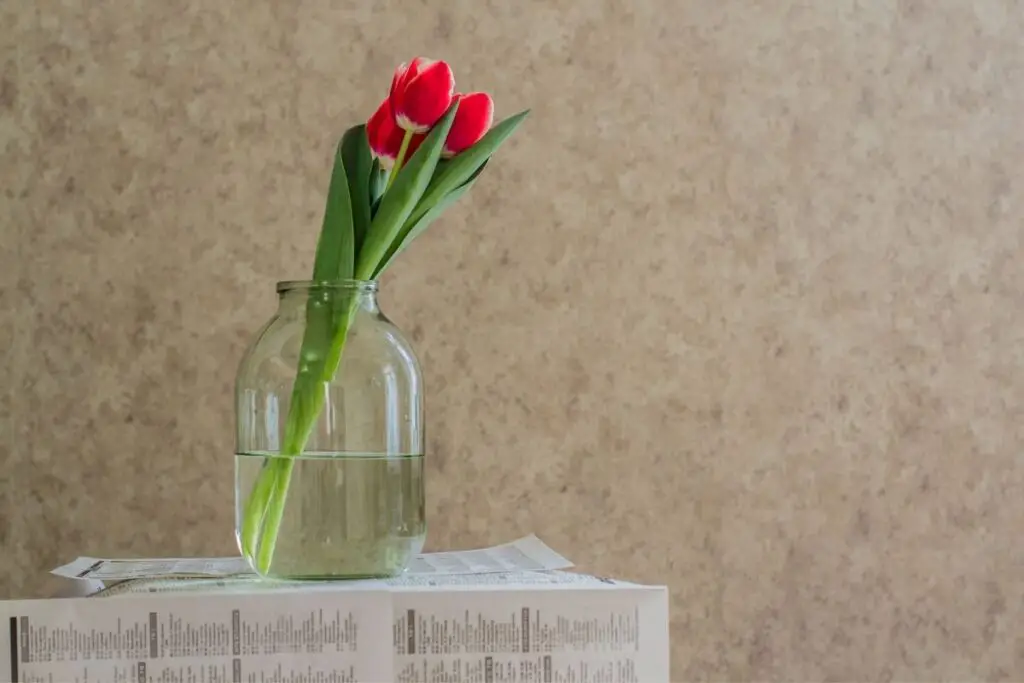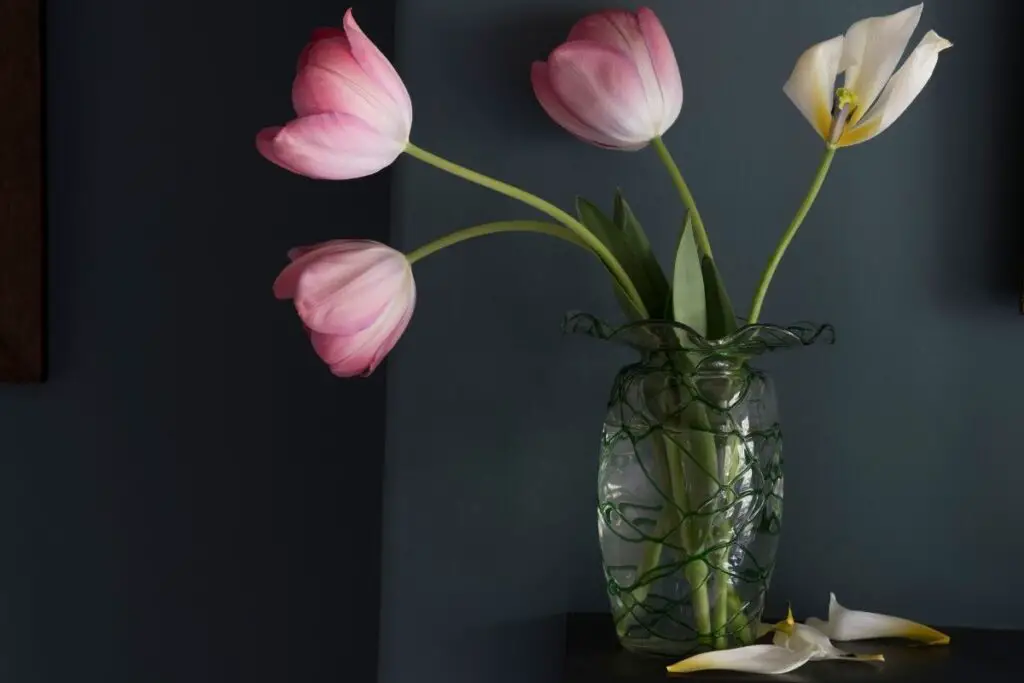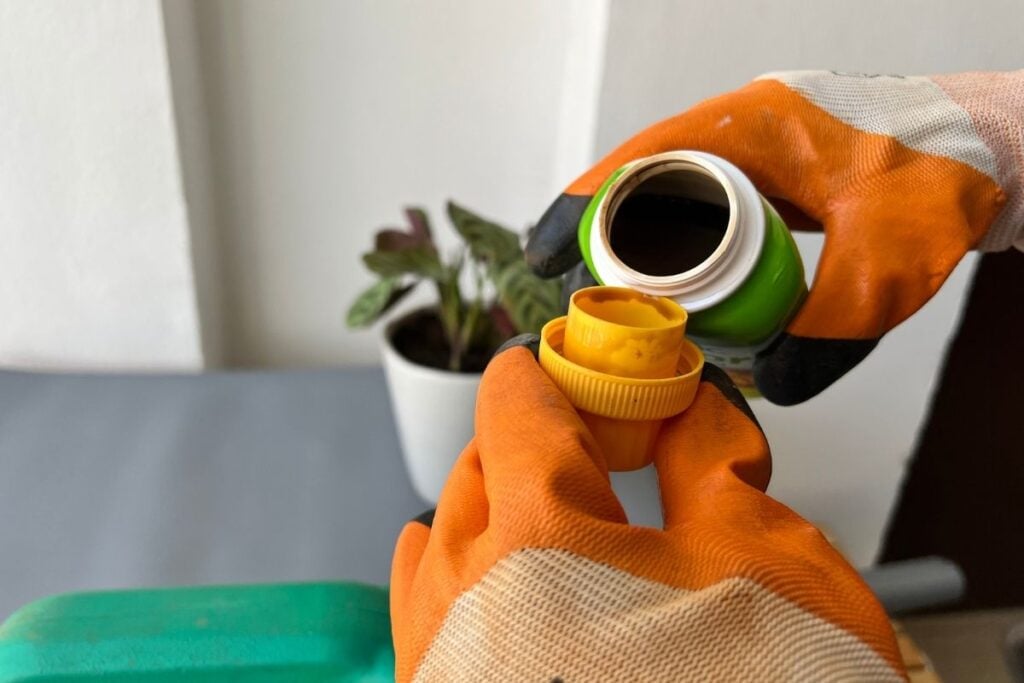Tulips are spring-blooming perennials valued for their vibrant flowers. Almost every variety of tulip has big flowers with systematic petal arrangements. It can be grown indoors as well as outdoors in soil.
But do tulips grow in water? Let’s find out.
As a general rule, tulips are usually grown in cold outdoor conditions where it gets everything to bloom. However, if you want to grow your tulips in water indoors, you need to cold-treat them to stimulate early blossom. Also, providing them with enough light and temperature is crucial.
The cold treatment or vernalization, followed by warming the bulb under sunlight, is crucial to trigger growth. You need to start four months ahead to provide an adequate cooling phase before planting or keeping them in the water.
Let’s know in detail how it works. We will learn the complete process of growing tulips in water.

How to grow tulips in water?
Let’s check out the basic requirements needed in this process.
Tulip bulbs: The first thing you need is healthy tulip bulbs. You can choose the bulbs from any flower shop or garden center. Go for large bulbs. Remember, the larger the bulbs, the bigger the blooms.
Don’t go for smaller bulbs as you won’t be satisfied with the results. The bulbs need to be pre-chilled for a certain period. The time duration varies and will be written on the packaging.
Glass container: You need to select a proper glass jar. The height of such glass jars provides support to the tulip leaves and stems as they grow. The best choice is a vase that has an hourglass shape.
The curved portion of the vase allows the tulip bulb to sit above the water with only the roots in the moisture. This reduces the chance of root rot among tulips.
Paper bag: You need this for pre-chilling your tulips in the refrigerator.
Water: How can we skip the need for water in this process when the whole process is with water? Just make sure to use good quality water that is free from any harmful elements. Try to use sterilized water in this process.
Rocks or glass beads: These need to be arranged at the bottom of the vase. If you are opting for an hourglass-shaped vase, you can skip putting glass beads.
These are mainly used to heighten the bulbs while being placed at the bottom of the vase. The roots coming out from the bulbs make their way through the glass bead bed.
Steps of growing tulips in water

After arranging all the necessary objects, the subsequent work follows a proper method for growing tulips. Here we have discussed a detailed guide to grow tulips in water from the bulbs. Let’s get into it.
Choose the correct bulbs and chill them
During autumn, choose tulip bulbs that are comparatively larger.
Tulip bulbs require an extended period of cold. Most of them require 3-4 months of exposure to cold. You can check the time on the bulb package, be sure to go through the instructions carefully to ensure the bulbs are kept accurately.
Each variety might have different cold requirements. Keep the bulbs in the refrigerator for the specified time after buying them.
A special tip: Don’t keep the bulbs near apples as the gas that comes out of them will not let the tulips bloom.
Chilling is an important and required step in this method. Do chill the bulbs as long as required and not less than that.
Chilling the bulbs breaks a cycle of dormancy and induces the plants to begin growth. So compromising with this step will result in no bloom.
Arrange the bulbs
Once you have chilled your tulip bulbs for the recommended period, bring them out of the refrigerator. Arrange the vase, rocks, and bulbs together.
Now place one or two handfuls of rocks at the bottom of the vase. The rock layer should be at least 2 inches deep. Now place the bulbs (3-4 bulbs in a group, depending on the size of the vase) above the bead bed.
Add additional rocks around the tulip bulbs to hold them in place and provide support.
Once the bulbs begin to grow, the roots will find their way through the layer of rocks and reach the waterline. The bead/rock layer provides a platform that keeps the whole bulb out of the water, thus reducing the chances of rot.
Provide sunlight and water

The final step includes filling the vase with water till it reaches the bottom of the tulip bulbs. Keep in mind not to emerge the bulbs in water.
If you are using a vase-shaped like an hourglass, you don’t need to add glass beads into it.
Just pour some water into the vase and place the bulb, which is big enough to fit at the curved region of the vase. The water should reach a layer about 1 inch from the bottom of the bulb.
Place this entire thing in a bright, cool room that gets indirect sunlight. Even a dark spot, too, can save the purpose. Keep the vase along with the bulb(s) for 4-6 weeks.
Change water weekly and witness your tulip sprout. The roots will automatically make their way to the water.
Within a couple of months, you can move the sprouting tulip bulb(s) to a well-lit spot where they get sufficient sunlight. This step is necessary to provide energy and encourage the growth of leaves.
If everything goes well, you will soon notice a rigid stem growing, symbolizing a mature tulip. Bud will grow at the tip of the center stem and will soon open up. The blossom will last a week or more.
Once the tulip bulbs have bloomed, maintain a constant moisture level and change the water whenever required.
Looking for gardening supplies? We have tested 100's of products before recommending them to you guys. Check out our best pick below:
| Image | Gardening Supplies | Best Price? |
|---|---|---|
 Top
Top Top
Top | Raised Garden Bed Kit | Check On Amazon |
 | XLUX Soil Moisture Meter, Plant Water Monitor, Soil Hygrometer Sensor for Gardening, Farming, Indoor and Outdoor Plants, No Batteries Required | No Results |
 Top
Top Top
Top | 82 Pcs Garden Tools Set and Extra Succulent Tools Set | Check On Amazon |
 | Joeys Garden Expandable Garden Hose with 8 Function Hose Nozzle, Lightweight Anti-Kink Flexible Garden Hoses, Extra Strength Fabric with Double Latex Core, (50 FT, Black) | No Results |
 Top
Top Top
Top | Dual Chamber Compost Tumbler | Check On Amazon |
 Top
Top Top
Top | Sunnyglade Plant Stakes | Check On Amazon |
 Top
Top Top
Top | Organic Cold Pressed Neem Seed Oil | Check On Amazon |
 Top
Top Top
Top | Mighty Mint Gallon :-Insect and Pest Control Peppermint Oil | Check On Amazon |
 Top
Top Top
Top | Scotts DiseaseEx Lawn Fungicide | Check On Amazon |
 Top
Top Top
Top | Jacks Classic 20-20-20 All Purpose Fertilizer | Check On Amazon |
 Top
Top Top
Top | 30,000 Seeds Pollinator Attracting Wildflower Mixture | Check On Amazon |
 Top
Top Top
Top | Survival Vegetable Seeds Garden Kit-Over 16,000 Seeds | Check On Amazon |
After the blooms fall
Once the bloom has faded, you need to make a decision.
If you feel the bulb is depleted after flowering, the easiest choice is to discard it. But if you expect another bloom cycle from the bulb, you can try. It is not an easy task as forced bulbs rarely rebloom. Still, you can give it a shot.
Start by removing the dead blooms and placing the tulips in a spot with adequate sunlight to collect energy. Let the tulip plants grow until the foliage dies back on its own.
Once the foliage becomes yellow and dry, cut it down and remove the bulb from the vase. Store the bulb in a dry and cool place until autumn and plant it with other fall bulbs. If you take proper care and are lucky enough, you may witness another bloom.
Some helpful tips
We are here with some ways that can simplify the entire process and can accelerate tulip’s growth.
- Try to get potted bulbs from the nursery or store. Don’t go for bulbs that have bloomed.
- Make the pot empty, and with care, remove the loose soil off the bulbs. Don’t damage the roots.
- Clean the bulbs with cool water and wash the excess soil particles.
- Trim the roots with sterilized pruners and keep them in a glass container with rocks. Follow all the directions.
How do you care for a tulip in water?

Proper care is essential for the optimum growth of any plant. If you wish to see vibrant tulip flowers adorning your indoor environment, you need to focus on their care routine in return.
We have listed some primary factors that need to be checked in tulip’s care routine.
Light
All varieties of tulips prefer full sunlight. However, while forcing the bulbs to grow in water, you need to understand the light requirement.
During the initial phase, the bulb needs to be kept under diffused/indirect sunlight. Once the bud starts sprouting, bring it near an open window to get adequate sunlight to cope with its energy needs.
Even after blossoms fall, the bulbs need to be kept under sunlight for a certain period until their foliage dries out completely.
Promoting photosynthesis and conservation of food for future needs is necessary when the plant is kept in a cold and dark spot before reblooming.
Also read: How Much Sunlight Do Tulips Need? (Tulip Light Needs)
Temperature
Tulips grow in regions with cool-to-cold winters and dry, warm summers. They require temperatures below 55°F for about 12-14 weeks to bloom, and in forced blooming, they need to be chilled.
So in areas without cool winter temperatures, they must be planted as annuals during the cold season. If you are staying in a warmer zone, not suitable for tulips, you must provide some cooling supplement to the plant.
Also read: What Temperature Do Tulips Need? (+Growing Them At Different Temperature)
Humidity
Being cold-loving varieties, tulips thrive well in a dry climate. Excess humidity of the rainy summer and monsoon can induce rot in tulips. Make sure your tulip bulb is not experiencing dampness.
Water
Water is an essential part of induced or forced blooming. Always use sterilized or distilled water. The water should be free from any heavy metals or any disinfecting agent, which can put toxic stress on the plant.
Don’t emerge the bulb entirely in water as it will lead to rot. Just allow the roots to enter the water.
Also read: How Often Do Tulips Need To Be Watered? (Tulip Watering Needs)
Fertilizers

Feeding tulips is not that necessary even when you are growing them in soil. So you can entirely skip this for tulips grown in water.
Just remember, if you ever wish to fertilize the tulips, do it during the wintertime with a diluted solution. Tulips remain active during the winter season. Never fertilize during summer as it is the dormant season for tulips.
You can add a solution of one teaspoon sugar and two drops of liquid bleach per gallon of freshwater for floral growth.
Also read: What Is The Best Fertilizer For Tulips? (Organic+Inorganic)
Pruning
If you plan to induce your plant for another bloom cycle, then go for pruning but not before the plant has naturally dried out.
Let the blossoms dry out completely and allow yellowing of the foliage. Only then go for trimming of the dead parts. Trim the roots to 2 inches before placing the bulbs in the vase.
Repotting
Repotting is not necessary unless and until you have decided to rebloom. Follow the previous steps of preparing the vase and bead bed for the fall bulb.
FAQ
What to put in water for tulips to last longer?
The first and foremost condition for lustrous growth is a clean vase with unadulterated water. The water should be at room temperature. Add cut flower food to the vase to accelerate growth.
How long do tulips in the water last?
If proper care is taken, tulips grown in a vase with water can live as long as 7-10 days.
Can tulips grow in water only?
Tulip bulbs can provide the earliest blossoms at any time of the year when grown in water. But a well-drained, slightly acidic, dry, sandy soil can support tulip’s growth, too, if proper light energy is provided.
We hope this article has been able to provide you with sufficient information regarding tulip propagation. Do your research and apply the strategies while adjusting the routine care for your tulips to multiply to add a brighter vibe to your inn.
Source: Wikipedia, North Dakota Stae University, The Royal Horticultural Society.
